Scotland's Climate Assembly - process, impact and assembly member experience: research report
Mixed methods research into Scotland’s Climate Assembly, including process, impact and assembly member experience.
5. Impact on climate policy and debate
This chapter presents an assessment of the impact of the Assembly on climate change debate and government policy in Scotland, based on data collected within the scope of this research (to 11 February 2022). It does not assess the viability of the recommendations with regards to implementation.
The analysis considers what, if any, changes in existing or planned policy can be directly attributed to the Assembly recommendations. Whilst not evidence of impact on policy, an overview of Assembly members’ views of the government response is also provided.
As the Scottish Government only published its response in December 2021, further research is required over a longer time period to assess impact on Scottish climate policy, and impact on debate, more comprehensively.
5.1. Impact on government policy
This section considers what impact the Assembly recommendations have had on Scottish Government policy to date, based on our analysis of the Scottish Government response to the Assembly recommendations[97], and on an assessment of the response by the Evidence Group presented to members in Weekend 8[98]. This includes the level and nature of Scottish Government support for the recommendations; and whether the recommendations broadly match or extend existing or planned policy, or whether they require new policy. The Evidence Group assessment considers the extent to which policy actions are likely to achieve the Assembly’s intentions. A review of other relevant government policy documents is also included.
Specific aspects of impact on government policy outwith the scope of this research report include:
- the impact of the Assembly within government.
- the longer term impact on policy development.
- outcomes of conversations between Scottish Government and UK Government on recommendations relating to reserved matters.
The Scottish Government response states that the Assembly has had a "profound impact" within government, giving the government a “mandate to act in some of the most challenging areas, and opening the door for new conversations now taking place across Government", and that this will have a "fundamental, enduring impact on future policy development” (p159). The response also states that “where Scottish Government action is not possible due to a lack of necessary powers, we will contact our counterparts in the UK Government directly to raise the Assembly's recommendations" (p159). A letter was sent on 1 March 2022[99].
In considering the impact of the Assembly there are several points to take into account:
- Assembly recommendations often include multiple ideas (as a consequence of the design process of clustering and consolidating outputs from the fifteen small groups – see 3.1.4 Developing the outputs). The Scottish Government response often expresses support for only part of the recommendation, or for the principle behind the recommendation.
- although the Assembly Report’s Statement of Ambition emphasises urgency, almost three quarters or recommendations do not have a specific timescale attached, nor do most recommendations contain targets or detail the scale of action.
- In Weekend 5, members heard evidence about the Climate Change Plan update and participated in a Q&A session. However, detailed scrutiny of all relevant policy was not part of the Assembly programme in the early stages (see 2.2.1 Assembly question), and members were therefore not necessarily aware of all existing and planned Scottish Government climate policy as they were developing their recommendations over the course of the Assembly.
Key findings
- The Scottish Government response is comprehensive, but the way it is written makes it difficult to identify exactly what the Assembly impact is on policy. No evidence of impact was found in other policy documents analysed.
- A third of recommendations appear to broadly match policy, with around a fifth being explored in some way albeit with no commitment to implementation.
- Over a third of recommendations include policies that will not be taken forward by the Scottish Government.
- 14 recommendations relate to UK Government reserved matters. However, the Scottish Government committed to contacting the UK Government about these, and has done so. There is one recommendation where an international convention prevents action.
- It is generally unclear in the government response how change will be implemented at the scale and urgency emphasised in the Assembly Report’s Statement of Ambition.
- Member survey results indicate that between the end of the main Assembly period and after receiving the government response, there is a decline confidence in the Scottish Government taking the Assembly seriously.
- There appears to be a mismatch in views and expectations, between the Scottish Government and the Assembly members, as to what constitutes an appropriate government response.
5.1.1 Scottish Government response
At 162 pages long, the Scottish Government response is comprehensive with cross-government contributions from all relevant policy areas. The response refers to 230 different strategies, plans, policies, schemes and initiatives.
The First Minister's Foreword states that:
"These recommendations have challenged us, in government, to do more, setting out a vision for our shared future. The response sets out actions we are taking to meet those recommendations, and where we will go further in those areas where the Assembly has encouraged us to be bold." (p4)
In the Next Steps section, it states:
"This response describes the actions that the Scottish Government is taking as a result of the ambitious recommendations". (p159)
However, whilst there is a lot of information about existing and planned policy, the way in which the response is written makes it difficult to identify the precise impact of the Assembly on policy. It is not always clear in the response exactly what, if anything, is new or additional or changed as a result of the recommendations.
In the Weekend 8 meeting Ministerial Q&A session, one Assembly member declared:
"We struggled to find a single example within the Scottish Government's response of a significant change that you have brought about as a result of our recommendations. The response document read basically as a catalogue of policies that were already in train or reasons as to why you couldn't do what we asked or couldn't do things within the timescale. The Assembly's work as you know represents thousands of man hours committed by people who want to see changes, and we felt that the document in response should have been framed differently. We didn't want a list of what we were already doing, we wanted a list of what you are now going to do differently because of what we said." (Assembly member, WE8)
A government Minister participating in the Q&A session replied:
“We’re all frustrated by progress… your work and recommendations do make a difference”[100]
The First Minister's Foreword highlights actions relating to three recommendations:
- support for a new network of sharing libraries (G1R6)
- increasing woodland creation and peatland restoration (G9R45)
- integration of emissions and emission reduction topics into education programmes (G8R40)
These recommendations are the clearest impacts of the Assembly in terms of influencing changes in policy, although peatland restoration was already a priority.
For each recommendation, the Scottish Government states its level of support or agreement. As shown in Table 5.1, just under half the recommendations are fully supported, with a similar proportion supported in part or in principle or with agreement with the aim or ambition.
Table 5.1 Scottish Government support for recommendations
Supports recommendation - 37
Supports part of recommendation - 11
Supports or agrees with principle, aim or ambition of all or part of recommendation - 25
Recognises ambition, need, benefit, importance of an aspect of recommendation - 7
No statement - 1
In keeping with its statements of support or agreement, the Scottish Government regards its climate actions and ambitions as "strongly aligned" with the recommendations.
Given the general absence of specific, measureable and time-bound objectives in both the Assembly recommendations and in the government response, it could indeed be argued that some recommendations are fairly well covered by existing or planned policy. Table 5.2 shows the results based on the phrasing of the recommendations. A third of recommendations broadly match policy, with around a fifth being explored in some way albeit with no commitment to implementing.
Over a third of recommendations include policy that will not be taken forward, including eight recommendations relating to taxation.
Table 5.2 Analysis of Scottish Government Response
Recommendation broadly matches existing or planned policy - 27
Recommendation extends existing or planned policy - 41
- commit to increased action (3)
- not doing extensions (19)
- already explored extensions and not doing (1)
- exploring or will explore, with no commitment to doing (18)
Recommendation requires new policy - 16
- exploring or will explore, with no commitment to doing - (6)
- not doing (5)
- unable to do, doing something else (5)
It is generally unclear in the response how change will be implemented at the scale and urgency emphasised in the Assembly Report’s Statement of Ambition.
The Evidence Group assessment finds a lower degree of alignment, having taken the messages in the Statement of Ambition into account along with the content of each recommendation. As shown in Table 5.3, two thirds of recommendations were judged to have been met with positive change but inadequate timing or ambition.
Table 5.3 Evidence Group assessment of Scottish Government Response
Actions broadly likely to achieve Assembly intention - 7
Actions don’t meet Assembly timing or ambition but positive change - 53
Actions insufficient to meet Assembly ambition, little or no change - 16
Recommendation and intention rejected or ignored - 5
The Scottish Government response states "where we have committed to taking action in future, we will provide updates to Assembly members to ensure we remain accountable for the steps we have set out in this response" (p159). Table 5.4 shows the number of recommendations where some kind of commitment is stated.
As noted earlier, on reserved matters, the Scottish Government also commits to contacting the UK Government, which it has done. There are 14 recommendations that relate to UK Government reserved matters, and one where an international convention prevents action.
Table 5.4 Scottish Government Response commitments
Will provide updates before end of 2022 (Goal 2 Building Quality) - 3
Will consider recommendation in future policy development or has already done so (explicit or implied) - 16
Welcome comments to National Planning Framework (NPF4) consultation - 5
Commit to feasibility study or review - 3
5.1.2 Other government documents
There are a number of other Scottish Government documents that refer to climate policies and actions with some relation to Assembly recommendations. These include:
- Just Transition Commission (headline recommendations, published 23 March 2021)[101].
- Bute House Agreement (shared policy agreement between SNP and Scottish Green Party, published 31 August 2021)[102].
- Programme for Government 2021-22 (published 7 September 2021)[103].
- Covid Recovery Strategy: for a fairer future (published 5 October 2021)[104].
- Heat in Buildings Strategy (published 7 October 2021)[105].
- Public sector leadership on the global climate emergency (Scottish Government guidance, published 29 October 2021)[106].
- Single-use plastics regulations (Scottish Government draft guidance, published 11 November 2021)[107].
- Scottish Budget for 2022-23 (published 9 December 2021)[108].
- Transport Scotland route map to achieve a 20% reduction in car kilometres by 2030 (published January 2022)[109].
Four of these documents mention the Assembly, but none provide evidence of impact on policy in terms of influencing change. The references to the Assembly in these four documents are discussed below.
Just Transition Commission (JTC)
The JTC recommendations document was published before the Assembly report. Under key message 3: empower and invigorate our communities and strengthen local economies, is Recommendation 15: Apply the lessons learned from Scotland’s Climate Assembly across the development of all policies for tackling climate change (p40). This is in regards to two actions (p58):
a) consider opportunities to run similar or other participatory approaches as part of an overall strategy to broaden and deepen opportunities for people to participate in shaping climate policy.
b) use the Assembly report as a tool for understanding the essential principles that need to underpin fair and just climate action, and once these principles are developed, to embed these across policy development to drive just transition, particularly leading up to the next full statutory Climate Change Plan (due for publication in 2023).
Lessons on running participatory approaches can be gained from this research report.
However, it is unclear how the Assembly report would be used to help the Scottish Government to develop a set of principles to underpin fair and just climate action.
Programme for Government
This document provides an initial response to the JTC recommendation as follows:
“We will continue to consider the range of mechanisms such as citizens’ assemblies, climate conversations and other community climate initiatives, to help inform and support the development of Just Transition plans and build on the legacy of Scotland’s Climate Assembly." (p55)
Again, this research report would be more useful in this regard than the Assembly report.
Heat in Buildings Strategy
This document states: “we… welcome the common direction of travel between the Assembly’s recommendations, published in June 2021, and this Strategy." (p28)
This reinforces the point made earlier about the perception of alignment between the recommendations and government policy rather than influencing change.
Transport Scotland route map
Under Opportunities for Change, the document refers to the percentage of members who voted in agreement with two Assembly recommendations, as evidence of public support for change (p5). As such, this does not demonstrate that the recommendations influenced the policy itself.
5.1.3 Assembly members’ views of Scottish Government response
Member’s views about the government response are not evidence of impact on policy, but the findings are useful to consider in this context.
After Weekend 7, just over half (54%) of respondents to the member survey agreed with the statement ‘I am confident that the Assembly report will be taken seriously by Parliament and political parties’.
In Weekend 8, members considered the Scottish Government response and heard from two Ministers[110]. As shown in Figure 5.1, only around a fifth of respondents to the Weekend 8 survey (22%) agreed ‘I am confident that the Scottish Government will fulfil the commitments made in the Scottish Government response’.
Assembly members produced a statement in reply to the Scottish Government Response. Just under a third of respondents (30%) agreed ‘I am confident that the Assembly Response will be taken seriously by Parliament and political parties’. Whilst these results should be treated with caution due to the lower numbers of members both attending Weekend 8 and completing the survey, the results indicate some loss in confidence in the Scottish Government taking the Assembly seriously. One Assembly member who lacked confidence in the Scottish Government to fulfil their commitments said:
“I'd say the main reason for this rating is that there are too many areas where the Scottish Government has indicated they are supportive but have made no real commitment to making changes, no actions specified other than vague promises to look into things / consider things” (Assembly member, WE8)
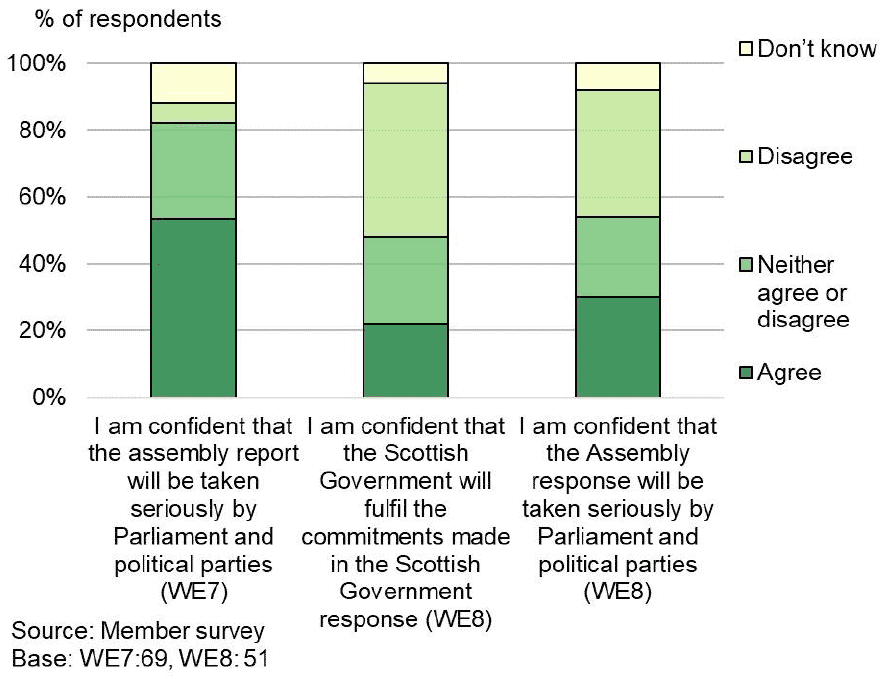
Members were asked about their satisfaction with the government response overall. As shown in Figure 5.2, over a third of respondents (38%) were dissatisfied, around a third neither satisfied nor dissatisfied (35%), and a quarter satisfied (25%). However, many members did not have much time to read and digest the long document. Some members noted during Weekend 8 that they had only just received a copy in the post or had not received it at all. Members were informed when the response had been published and were sent a link, but as discussed earlier (see 2.3.1 Planning the Assembly), such ‘homework’ cannot be expected to be done by all members. There was no time allocated during Weekend 8 for members to read the response. In the survey, only 10% said they had read all of the document before the weekend, with a third (34%) reporting reading more than half and 44% reading less than half. This could explain the large proportion who reported being neither satisfied nor dissatisfied. For example, one member commented:
“Due to change of address I only received the digital response on Friday afternoon so can't comment on my satisfaction over the government's response until I have more time to look through it” (Assembly member, WE8)
Nevertheless, around half of respondents found the response easy to understand. Around two thirds agreed that the Evidence Group’s assessment of the Scottish Government Response reflected their views, with a similar proportion finding the assessment useful in shaping their views.
A third of respondents reporting being neither satisfied nor dissatisifed with the Ministers’ answers to the members questions as part of the Ministerial Q&A session.
There was no clear instruction in the Climate Change Act as to the precise nature of the response that should be produced. But feelings of satisfaction or dissatisfaction indicate that members held some kind of expectation, even if these were not fully conscious or explicitly expressed. The statement produced by members during Weekend 8 calls for a "clearer roadmap". Most of the Scottish Government Responses to the recommendations do lack detail about actions and timescales for delivery, although some do provide information about budgets. However, producing an action plan was not a specification of the Climate Change Act. The requirement was to "publish a statement setting out how they intend to respond to the recommendations".
There appears to be a mismatch in views and expectations, between the Scottish Government and the Assembly members, as to what constitutes an appropriate response.
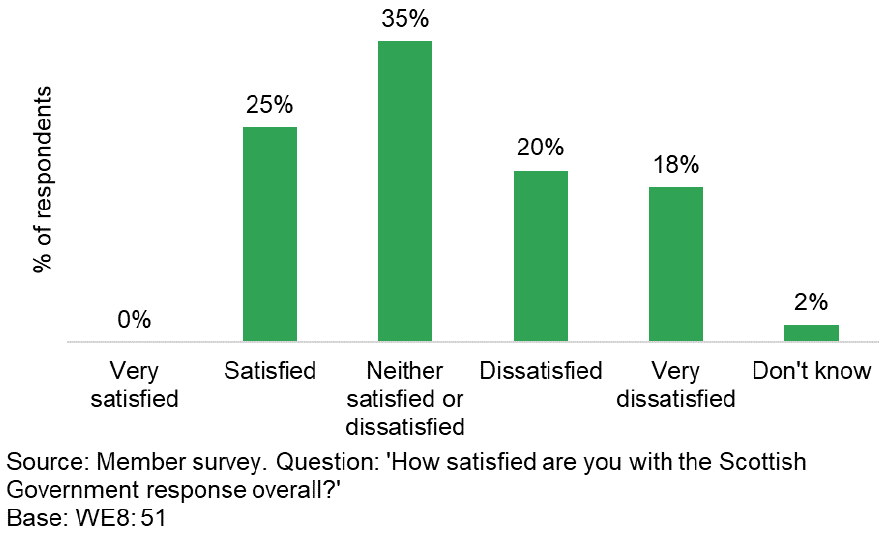
With regards to the Assembly’s Statement of Response produced in Weekend 8, members were asked about their ownership of it. As shown in Figure 5.3, six in ten respondents (61%) agreed that their views were reflected in the statement, yet more than half the respondents (55%) disagreed that there had been enough time to satisfactorily finalise the statement. Perceptions of insufficient time is a recurring theme in member experience, as discussed earlier in the report (see 2.3.4 Programming the sessions).
One Assembly member explained:
“It is always difficult to take on board the varied opinions of so many people in such a short space of time. In our group we tried to incorporate the feedback and suggestions made to us by other groups but I did not feel that other groups took on board the suggestions made to them and the views of our group were echoed in the comments by other groups too and for this reason I am not sure that the Assembly response will reflect a true reflection of member's views.” (Assembly member, WE8)
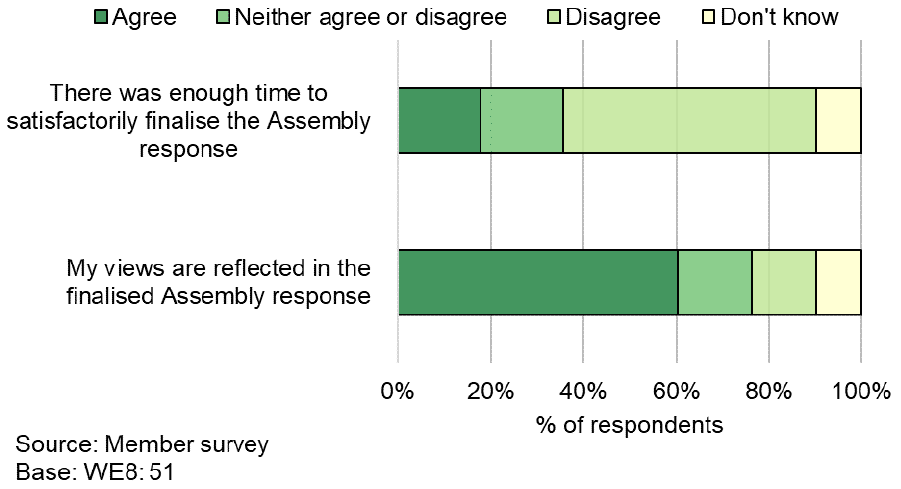
5.2. Impact on debate
This section considers the impact of the Assembly on climate change debate in Scotland through an analysis of media coverage. Citizens’ assemblies include only a small number of participants, and media coverage is one way to bring more members of the public into the conversation. Analysing media coverage provides some insight, albeit limited, into the presence and influence of the Assembly in public discourse. Furthermore, media coverage may increase the salience of climate change generally, or particular topics and themes, in the minds of policymakers as well as the public.
The analysis in this report focussed on online written news media coverage. Broadcast news and social media analysis are outwith the scope of this report. The impact of the Assembly’s Civic Charter[111]is also outwith the scope of this report, although media coverage of the Charter is included as part of the media analysis.
The media analysis findings presented in this section include the amount, location and nature of the coverage, and how it changed over the course of the Assembly.
The analysis spanned 16 months, from the first article published 2 November 2020 until 11 February 2022[112]. The analysis was structured into four phases[113]:
Table 5.5 Media analysis coverage by phases
Phase 1
1 Nov 2020 – 31 March 2021
covers the beginning of the Assembly and the publication of the Interim Report
Phase 2
1 April – 30 Sept 2021
covers the publication of the full Assembly report and associated public engagement activity
Phase 3
1 Oct – 30 Nov 2021
covers the period of COP26[114]
Phase 4
1 Dec 2021 - 11 Feb 2022
covers the publication of the Scottish Government’s Response to the Assembly recommendations and Weekend 8 of the Assembly
Key findings
- The media coverage of the Assembly was dominated by three Scottish based news outlets (as per Citizens’ Assembly of Scotland).
- Higher levels of coverage occurred when the Assembly published its final report and during COP26.
- The coverage was primarily neutral or positive (41% and 40% of all coverage respectively).
- The analysis shows that the Assembly has contributed to climate change debate in online news media. However, in the absence of a counterfactual, the way in which it has changed the debate is unknown.
- The Scottish Government’s Response has received little media coverage to date.
5.2.1 Amount and type of media coverage
A total of 151 articles were identified and analysed across the four phases, from 52 online news media outlets. This is less coverage than the Citizens’ Assembly of Scotland received (206 articles)[115], which could be because that was the first citizens’ assembly in Scotland and therefore more newsworthy. It should be noted that the Climate Assembly may yet receive further coverage following discussion of the Scottish Government response in Parliament[116], and with further policy responses and developments.
Figure 5.4 shows the extent of media coverage for each phase by month. In keeping with other citizens’ assemblies[117], the media coverage was greatest around the launch of the full Assembly report (in Phase 2) when journalists have tangible outputs to report and discuss. There are also spikes in coverage at the end of Phase 1 when the Interim Report was published[118], and also during COP26 (Phase 3). Despite Phase 3 lasting only two months (the shortest of the phases), the Assembly received 20% of its coverage during this period. This is likely due to public engagement activities such as the launch of the Civic Charter (a third of Phase 3 coverage referenced the Charter), and Assembly-related COP26 activities, and because climate change was higher on the news agenda at that time.
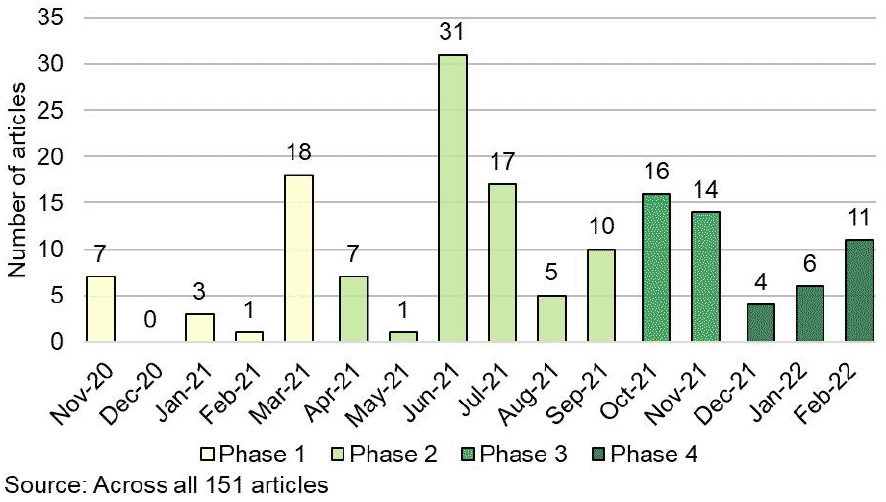
Phase 4 coverage is lower than might be expected given the Scottish Government response was published 16 December 2021. This could be due to resurgent media focus on the Covid-19 pandemic[119], media scrutiny of the UK Prime Minister over reported lockdown social activities, and the proximity to Christmas, all of which could have overshadowed the publication of the Scottish Government’s response. However, it is also possible the Scottish Government’s response to the Assembly was not deemed newsworthy. Previous research indicates that citizens’ assemblies get more media coverage the greater the perceived impact of the assembly on policy[120]. Indeed, as shown in Figure 5.4, coverage increases in February 2022 coinciding with Weekend 8 of the Assembly, when two Ministers participated in a panel Q&A with members.
Focused coverage
Of the 151 articles, 60% (90 articles) focused on the Assembly whilst 40% (61 articles) only mentioned it. As shown in Figure 5.5, in Phases 1 (during the Assembly) and 4 (Government response) the Assembly tended to be the main focus of the coverage.
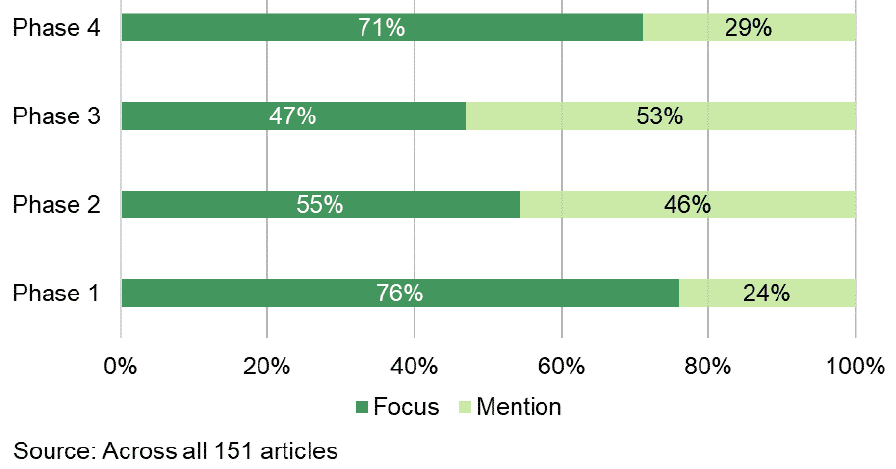
Mentioned coverage
Just over a third of the 61 articles that mentioned the Assembly used the Assembly and/or its recommendations as evidence to support a claim or argument (23 articles). Over half of these (13 articles) supported a climate change related topic (e.g. on transport, housing or the economy). Of these, 11 articles used the Assembly outputs as evidence. For example, one articled cited the Assembly’s Recommendation for a ‘Frequent Flyer Tax or Levy’ as evidence for tougher governmental commitments on taxing frequent fliers:
“In the Government’s upcoming Aviation Strategy, we'd like to see ministers robustly explore taxing frequent fliers who are making the climate crisis worse, as suggested late last year by a majority of the 100 members of the public who took part in Scotland's landmark Climate Assembly. At best, this could cut aviation demand and therefore emissions, at worst it would generate money for wider climate action.” (Jamie Livingstone, Head of Oxfam Scotland, The Scotsman, 18 January 2022)
The other 10 articles used the Assembly and/or its recommendations to support a claim or argument about democracy e.g. citing the Assembly as evidence for further investment in similar deliberative processes. For example:
“The assembly process confirmed to us that (1) putting democracy back in the hands of ordinary people is the way forward, and (2) that the new democracy has to emerge from the people and not be controlled by the government.” (Justin Kenrick and Eva Schonveld, Good Men Project, 31 January 2022)
Distribution
The distribution of articles amongst outlets was varied. In total, there were 52 outlets that covered the Assembly[121]. Figure 5.6 shows the outlets with 3 or more articles. The ‘Other’ category contains 38 outlets publishing 46 articles (each outlet had one or two articles on the Assembly). The chart shows that media attention was concentrated in only a few outlets. Most of these outlets were Scotland-wide (74%), followed by UK-wide (15%), local or regional in Scotland (7%) and international (4%).
Three outlets produced 40% of the media coverage (The Herald, The National, and The Scotsman), and are Scotland-wide. These outlets also produced most of the media coverage for the Citizens’ Assembly of Scotland[122]. Topics in the articles across these three outlets were similar to the remaining 49 outlets: around two thirds of articles in both sets of outlets discussed climate change, just under half of articles discussed at least one Assembly output, and a just under a third of articles commented on the Assembly process.
Skew
The skew of coverage refers to how the Assembly was portrayed in the media: neutral skew (where the media primarily described the Assembly and/or its outputs without evaluation); positive skew (where the article provides positive comments on the Assembly); negative skew (where the media provides a critique of the Assembly); or balanced skew (where the article provides both positive and negative perspectives of the Assembly, providing a balanced argument).
40% of the articles were positive, 41% neutral[123] and 11% were balanced. 8% of articles were negative skew (8%, or 12 articles).
Almost all of the negative skew articles (11 out of 12 articles) critiqued the evidence presented at the Assembly. Most of these were written by climate activists (8 articles), seven of which by former Stewarding Group members who represented Extinction Rebellion (XR). This is discussed in more detail in section 5.2.3 Coverage of Assembly process.
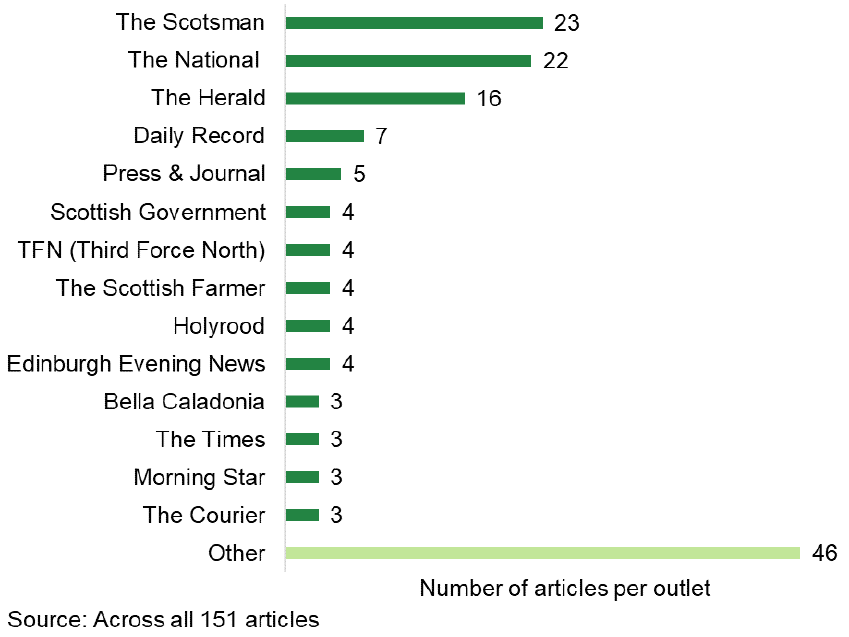
Author and perspective
63% of all articles were written by a journalist or editor. The remaining were spread fairly evenly between: academics, climate activists, members of the public, Climate Assembly Organising members, and the Scottish Government.
The media analysis also captured the voice or perspective featured in the articles, such as through use of quotes. In total, 13 different perspectives were categorised. The most common perspectives were from politicians, Organising members, and informants or advocates who presented evidence to the Assembly. Of the 19 articles that included the voice of an Organising member, 14 included the voice of a Co-convener.
Of these, 12 were positive and the remaining two were neutral. This shows how conveners could fulfil their role as advocates for Assembly members through the media.
5.2.2 Contribution to climate change debate
The Assembly featured strongly in 94 articles that discussed climate change (62% of all coverage).
Articles that focused solely on the Assembly outputs with no wider discussion of climate change, for example, articles that only contained the Statement of Ambition, were not considered as contributing to the climate change debate.
The proportion of articles discussing climate change was relatively consistent across the lifecycle of the Assembly, with 62% of all articles in Phase 1 and Phase 2, 63% in Phase 3, and 62% in Phase 4 discussing climate change.
As can be seen in Figure 5.7, ‘urgency in response to the climate emergency’ is the most frequent topic (57 out of 94 articles), covering the speed at which climate impacts are occurring, and/or the urgency of actions required in response. For example:
“For anyone who was still wondering what needs done on climate change, it’s writ large here: much more, and much faster” (Professor Dave Reay of Edinburgh University’s Climate Change Institute, speaking about the Assembly report, The National, 24 June 2021)
The second most frequent topic is ‘climate justice’ (47 articles). Both topics were covered in all phases to some degree. The popularity of these topics could be due to framing of the Assembly question: How should Scotland change to tackle the climate emergency in an effective and fair way?
“The climate crisis is a threat to everyone, but it falls hardest and fastest on the shoulders of the most vulnerable among us.” (Josh Littlejohn, Social Bite founder and co-convener of the Assembly, The Daily Record, 25 October 2021)
Figure 5.7 also shows that of the articles discussing climate change, there is a greater focus on mitigation (42/94) compared to adaptation (4/94). Adaptation only featured in Phase 2 (Assembly report). This imbalance mirrors the lower level of attention given to adaptation in the Assembly (see 2.4.1 Selection of evidence).
The theme of ‘Scotland as a pioneer’ also emerged, with 28 articles discussing Scotland’s role at the forefront of climate action. This was a theme in the Assembly’s Statement of Ambition, and featured in the goals and recommendations.
With regards to changes required to tackle climate change, transformational change (24/94) was discussed twice as much as incremental change (11/94). These findings are the reverse of the Assembly recommendations where incremental change was promoted twice as much as transformational change (see 2.2.3 Assembly recommendations and systems change).
There were 43 articles that attributed a responsibility to tackling climate change. As articles often included quotes from different people, they sometimes attributed responsibility to multiple levels, for example, both Government and individual responsibility. Of the 43 articles, most (28) attributed responsibility to Government, 17 articles to all of society and 7 articles to the individual. As discussed earlier see (3.4 Climate attitudes), a lower proportion of Assembly members responding to the Weekend 7 survey and the Scottish public think that tackling climate change is primarily the Government’s responsibility (16% and 20% respectively).
These results demonstrate that media coverage can, but does not always, follow patterns in the Assembly itself.
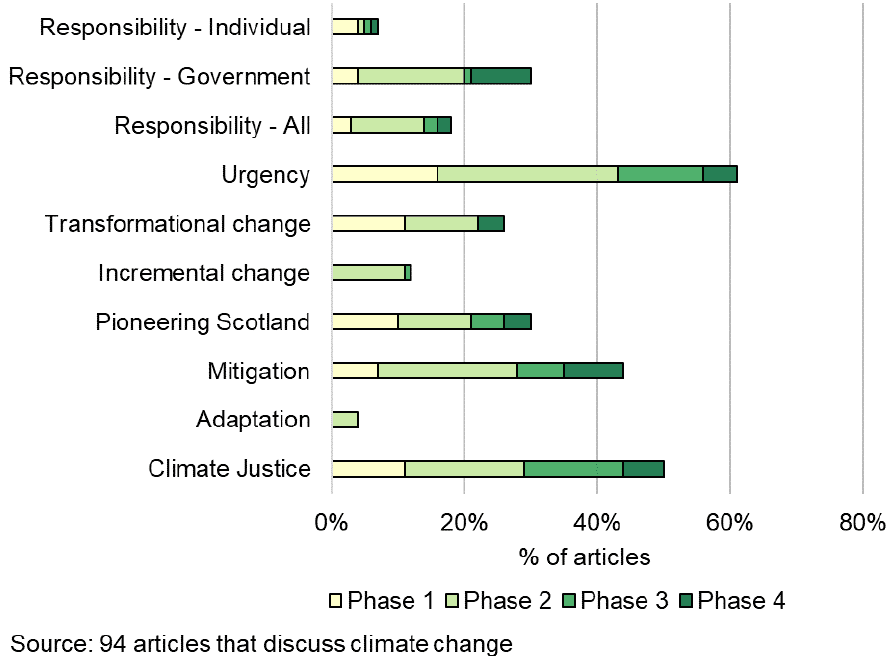
5.2.3 Coverage of Assembly process
The Assembly process, specifically governance and design, was discussed in 26 articles. As shown in Figure 5.8, most were published during Phase 1 on topics including the approach taken by Organising members, the type of evidence presented to members, and the role of Extinction Rebellion (XR) in the Stewarding Group. This concentration on process in Phase 1 is understandable as during the Assembly the media do not have outputs to discuss. This finding is in keeping with research on the Citizens’ Assembly of Scotland and the Climate Assembly UK[124].
Governance and design
Figure 5.8 shows the number of articles by topic. The most common topics relate to: critiques of the evidence presented to Assembly members (18 articles), critiques of the approach that the Assembly took (i.e. that it was not radical enough to tackle the climate emergency) (17 articles), and neutral descriptions of XR leaving the Stewarding Group (14 articles). 12 articles discussed all three topics, and a further 3 articles discussed two of these topics. For example:
“Extinction Rebellion Scotland was originally part of the Stewarding Group, but pulled out because they felt that those with an interest in maintaining the status quo were frightened of rocking the boat, and were not allowing the Assembly to hear a wide enough range of evidence. XR wanted assembly members to be supported to decide how serious the emergency is, assess the systematic drivers of the crisis, and decide the level of transformation required.” (Edinburgh Reporter, 4 March 2021)
XRs voice featured in almost half of the articles which covered the governance and design of the Assembly.
Some articles were supportive of the evidence Assembly members received (9 articles). Most of these had a balanced skew on the Assembly as a whole (7 articles).
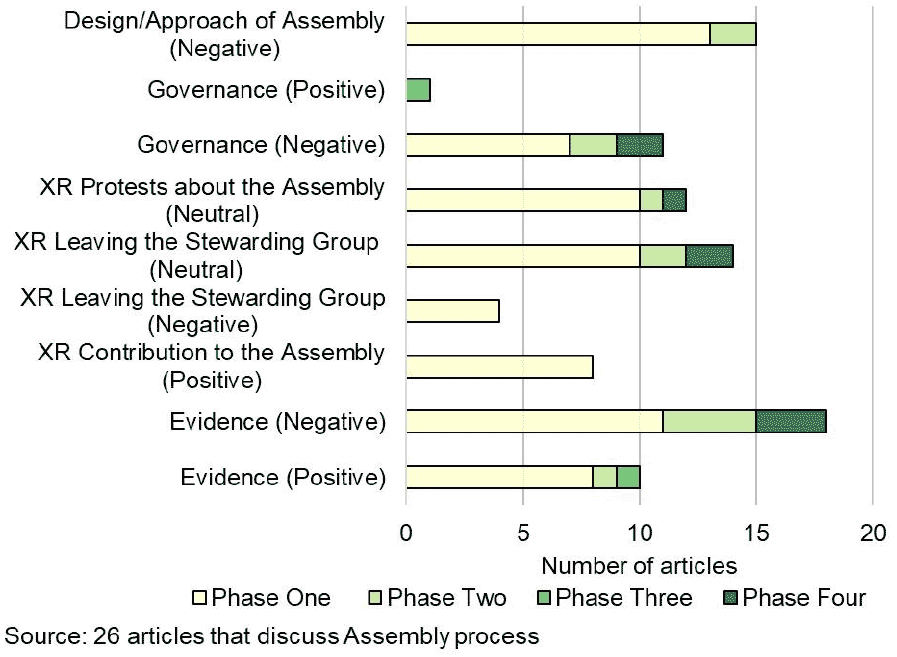
Democracy
Two thirds of articles on Assembly governance and design framed the discussion within a wider narrative about democracy[125] (16 articles). For example:
“In a world where democracy can often feel like little more than an X in a box every four years, this climate assembly is a chance for 105 citizens of Scotland to do what politicians are too afraid to do: save us from a future of drowned cities, scorched earth and millions forced to flee their homes, by refusing business as usual. Instead let’s hope they call on us to embark on the transformations needed to stop the destruction of our only home and ensure a bright future for all.” (Bella Caledonia, 4 March 2021)
Children’s Parliament
In addition to the articles on Assembly process, a further 22 articles discussed the involvement of Children’s Parliament in the Assembly. Of these, 18 had a positive skew and the remaining were neutral. For example:
“Some of the strongest and most coherent thinking came from the youngest in our community, that is the children’s parliament” (Kairin van Sweeden, climate justice activist, The National, 11 September 2021)
Half of these articles were published in Phase 2 when the full Assembly Report was published which included the Children’s Parliament ‘Calls to Action’ (see section 1.2 footnote 16).
5.2.4 Coverage of Assembly outputs
79 articles discussed the Assembly outputs including the Statement of Ambition, goals, recommendations and the Assembly members’ Statement of Response to the Scottish Government. Of these, around half of the articles (42) had a positive skew on the Assembly and about a third had a neutral skew. The articles that had a positive skew were dominated by the voice and perspective of organising members, politicians and experts/speakers from the Assembly who accounted for around two thirds of these articles.
Statement of Ambition
The Statement of Ambition was covered in 17 articles. 13 of these articles had a positive skew on the Assembly, with the remainder neutral. However, much of this positivity came from content that included the voice of someone involved in the Assembly rather than journalists (i.e. Organising members, experts/speakers, or organisers/members of Children’s Parliament). This shows that self-generated media coverage is a good way for organisers to get positive messages about the Assembly into the public domain[126].
Goals
32 articles covered the Assembly goals. Almost all goals were mentioned at least once. There was no specific mention of Goal 7 Carbon Labelling, Goal 11 Circular Economy, Goal 12 Work & Volunteering, and Goal 13 Business[127]. However, the recommendations accompanying these goals did receive attention.
Across the 52 outlets, 22 of them covered the Assembly goals, with the main three outlets (The Herald, The National and The Scotsman) accounting for just over a quarter of the articles.
The goals that received the most coverage were: G15 Taxation (24 articles), G9 Land Use (19 articles) and G8 Education (8 articles). Five of the 16 goals received explicit support in the media[128]: G8 Education, G9 Land Use, G14 20 Minute Communities, G15 Taxation, and G16 Measuring Success. Taxation was the only goal to be critiqued (once in The Herald and once in Scottish Land and Estates). The Assembly goals received relatively low coverage compared to the recommendations[129].
Recommendations
The Assembly produced 81 recommendations[130], and 50 of these were captured in the media coverage. Two thirds of outlets covered the recommendations across a total of 73 articles. However again, the coverage was heavily dominated by the three main outlets (The Herald, The National and The Scotsman) who together accounted for just over a third of the articles. Of the articles that covered the recommendations, just over three quarters (57) were focused on the Assembly (as opposed to only mentioned) and the same proportion (57) were focussed on the topic of climate change. Indeed, almost all (53/57) of those articles focussed on both the Assembly and the topic of climate change.
Some recommendations were discussed more than others. Those receiving the most coverage were: G3R14 Decarbonising Heating by 2030 (19 articles), G5R28 an Oyster Card for Scotland (16 articles) and G12R57 National Nature Service (15 articles).
Around two thirds of articles discuss more than one recommendation.
Twenty recommendations received positive coverage, in 21 articles. Around half of these articles were opinion pieces. Politicians (7 articles) and Assembly members (5 articles) were the most prominent perspectives that were highlighted in these articles. The recommendations were from almost all the different goals (14 out of 16 goals).
There was also some negative coverage, with 8 recommendations critiqued in 8 articles. These recommendations mirror the recommendations receiving lowest percentage of votes from Assembly members (see 4.1.3 Support for recommendations). Five of the recommendations are from Goal 15 Taxation, which received the lowest voting agreement from the members (see 4.1.2 Goals). However, the most criticised recommendation (in 4 articles), was Food Carbon Labelling, which was voted for by 95% of members.
Most of the articles that covered a recommendation neutrally were informative (49 out of 60 articles) with the rest as opinion pieces.
Assembly members’ Statement of Response
After Weekend 8 (to the cut off date for Phase 4 analysis) there were 5 articles that covered the Assembly members’ Statement of Response. As previously stated, this response was produced by the members following a weekend where they considered and reflected on the Scottish Government’s response to the Assembly’s goals and recommendations.
To date, the Scottish Government’s response has received a relatively small amount of media coverage – just 13 articles contained references to the Scottish Government response to the Assembly Report. Inevitably, all of these were in Phase 4. Of these references, just over half were unsupportive of the Scottish Government response (7 articles). Just under a third (4 articles) were neutral; and 2 articles praised the response. The Scottish Government’s response to the Assembly, and the Assembly report itself, may receive more media coverage following discussion in Parliament[131] and further policy responses and development.
Contact
Email: socialresearch@gov.scot
There is a problem
Thanks for your feedback